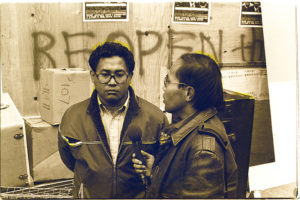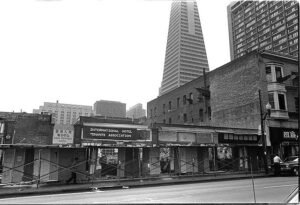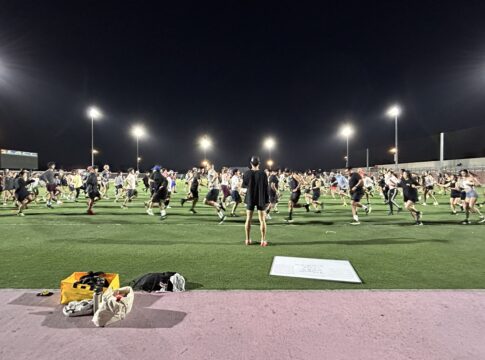
By Randall Yip
(Note from the Editor: Randall Yip covered the International Hotel in the two years leading up to the eviction for both East West and the San Francisco Journal, two Asian American publications that have since ceased publishing.)
Caroline Cabading’s grandfather lived as a young man along San Francisco’s Kearny Street in the 1930’s in what was then known as Manilatown.
Emil De Guzman was a young student activist who lead the Third World Strike in 1969 at UC Berkeley.
Curtis Choy was an idealistic documentarian who amplified his voice through his camera.
LATEST STORIES
Their three lives all intersected 40 years ago in the wee hours of August 4, 1977 in San Francisco at a single resident occupancy hotel. The International Hotel was the last bastion of a robust 10-block center of Filipino Americans in San Francisco. By then, the hotel was all that was left of the once bustling community. It stood at the edge of both the Financial District and Chinatown. The Manilatown Heritage Foundation says between 1920-1935, the neighborhood was home to 39, 328 Filipino males.
“If we don’t talk about it, it’s as if it never existed,” said Cabading to AsAmNews. The interim Executive Director of the Manilatown Heritage Foundation says the Filipino American community has three times been forced out of its ethnic enclaves in San Francisco by land grabs- once in the Fillmore, another in Manilatown and more recently Yerba Buena.
Overtime, Manilatown gave way to redevelopment and Downtown business interests.
A corporation with strong political ties was poised to evict the tenants and tear the hotel down.
In 1977, protesters made one last stand for Manilatown. 3,000 demonstrators linked arms to form a human barricade in front of what was affectionately known as the I-Hotel in hopes of protecting the elderly tenants from eviction.

Across from them were 400 riot police ready to swing their batons to forcibly remove the remaining 55 mostly elderly tenants. Some of those officers were on horseback.
It was the unfortunate culmination of a nine year struggle both on the streets and in the courts in a valiant effort to save the International Hotel and what little was left of Manilatown.
In 1968, Milton Meyer & Co. issued eviction notices. Their dream was to demolish the hotel for a parking garage. The company was run by San Francisco billionaire Walter Shorenstein, a big contributor to the Democratic Party and then presidential candidate Hubert Humphrey.
Shorenstein gave way to mounting pressure and agreed to lease the hotel for three years to the United Filipino Association.
The Association was run by student activists such as De Guzman. The UFA rented the basement of the hotel to community groups including Kearny Street Workshop and businesses such as Everybody’s Bookstore to finance the lease.

“We were fortunate to win a grant to set up recreation programs to bring people together: bingo games, movies, field trips to beaches, parks, and camp sites” De Guzman told AsAmNews. “The aim was to create a friendly atmosphere where people could enjoy each other. Medical students, dental students, nurses, Berkeley, SFSU, UC Davis, even elementary students all came together to help, meet and work for the tenants.”
De Guzman in 1972 moved into the hotel at the age of 24 and became President of the International Hotel Tenant’s Association which took over from the United Filipino Association.
In ’73, Shorenstein sold the hotel to the Four Seas Investment Corporation of Thailand. The following year, Four Seas issued new eviction orders.
Over the next three years, tenants, students and community organizers mobilized.
Four Seas and its team of corporate lawyers successfully fought back every challenge.
“The class divide of wealth, gentrification, homelessness, and unaffordability became apparent then, and has become worse,” said Curtis Choy who documented the eviction in his film, The Fall of the I- Hotel. “Everyone knew this and came out from all corners of the City to support I-Hotel tenants in this struggle against Goliath,” he told AsAmNews.

In a creative bid to stop the eviction, the tenants along with San Francisco Mayor George Moscone came up with a plan to loan the tenants money to purchase the hotel and convert it to public housing through eminent domain.
The plan was approved, but later overturned through appeals and by the state Supreme Court.
However Sheriff Richard Hongisto refused to obey a court order to evict the tenants. He served five days in jail for contempt of court.
“I was glad Hongisto took a stand, but he was under tremendous pressure to do his job or get recalled,” said De Guzman. “I visited him at San Mateo County Jail and asked him not to follow through on the judge’s order. In the end, he chose to evict”
The liberal sheriff did, however, make one concession to the protesters. He agreed to notify them in advance when the eviction would occur.
Tenant organizers got the word and immediately mobilized a phone tree to alert their supporters. Despite an eviction carried out well past midnight. thousands came to form a human barricade.
So many came that police cordoned off the area to prevent any more from joining the protest.
Among those in the human shield were the aunt and uncle of Cebading.
Police used their batons to move away protestors, then used sledge hammers to break down the doors of the hotel to get to the tenants. Leading the charge was Sheriff Hongisto.
One by one, the tenants were removed from their rooms and into the street. All this was done under the glare of flashbulbs and TV lights. The eviction received both local and national coverage.
“Only by dumb luck did I get wind of the impending eviction, and was able to film it,” said Choy.”The sheer level of noise and disbelief that the inevitable had hit the fan was surreal. I would have truly felt helpless in the line being pummeled by cops, and was thankful I had a job to do, and a camera to duck behind. And I knew I might have the only filmed recording from “our” side.”

In all, 197 tenants were evicted. The hotel was demolished in 1981 under the weight of the wrecking ball.
Despite that, the old I-Hotel site is the location of the new International Hotel Senior Housing and I-Hotel Manilatown Center.
In 1994 the I-Hotel land was sold to the Catholic Archdiocese of San Francisco. An $8.3 million dollar Housing and Urban Development Grant was awarded for low income housing. The Chinatown Community Development Center was chosen to oversee the construction of low income housing.
Construction began in 2003 and the building was completed with 100 units of low income housing in 2005-28 years after the eviction. The Hotel shares space with St. Mary’s Chinese Catholic Center.
Cabading sees this only as a partial victory.
“By the time it was built, they(the evicted tenants)had passed away,” she said. “It couldn’t make up for being an elderly person and having a sledge hammer slammed through your front door. A rebuilding of a building doesn’t make that up.”
Out of the 197 tenants evicted, De Guzman knows of only two who were able to move into the new I-Hotel, James Walsh and Rudy Data.
He believes the struggle has left a lasting impact.
“The one big change afterwards was the creation of non-profit developers who were supported by the city to buy, renovate and provide affordable housing for low income people. It was either that or more I-Hotels would be on the horizon. I thought this was a significant change copied by other cities.”
On Friday night August 4 from 6 – 9 p.m., a 40th anniversary panel discussion will be held at the Manilatown Heritage Foundation to commemorate the 40th anniversary. A free screening of The Fall of the I-Hotel will also be held.
AsAmNews has Asian America in its heart. We’re an all-volunteer effort of dedicated staff and interns. You can show your support by liking our Facebook page at www.facebook.com/asamnews, following us on Twitter, sharing our stories,interning or joining our staff.









RE: The Night Asian America Took One Last Stand: 40 Years after the Fall of the I-Hotel: “In 2017, protesters made one last stand for Manilatown.”
Is that right? Seems like that was in 1977? Confusing.
RE: Michele Playfair The Night Asian America Took One Last Stand: 40 Years After the Fall of the I-Hotel. Thank you for pointing that out to us. We’ve clarified the headline
RE: The night Asian America took one last stand. Remembering 40 years after the fall of the I-Hotel: I remember my Paper Route for the News Call Bulliten and one of my deliveries was to the International Hotel , in 1967 I remember all the Old Filipino men smoking and reading the papers, I was astonished when they closed the hotel down ? Shima Sakata I lived two blocks away on 1022 Kearny St.